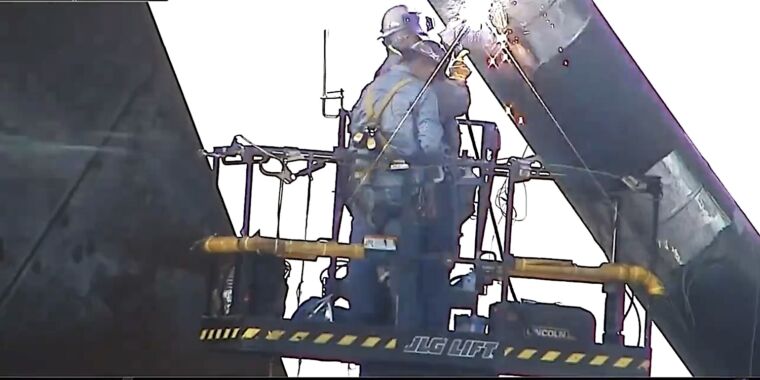Pretty much every day for the last couple of weeks, workers wielding welding guns and torches have climbed onto SpaceX’s Starship launch pad in South Texas to make last-minute upgrades ahead of the next test flight of the world’s largest rocket.
Livestreams of the launch site provided by LabPadre and NASASpaceflight.com have shown sparks raining down two mechanical arms extending from the side of the Starship launch tower at SpaceX’s Starbase launch site on the Gulf Coast east of Brownsville, Texas. We are publishing several views here of the welding activity with the permission of LabPadre, which runs a YouTube page with multiple live views of Starbase.
If SpaceX has its way on the next flight of Starship, these arms will close together to capture the first-stage booster, called Super Heavy, as it descends back to Earth and slows to a hover over the launch pad.
This method of rocket recovery is remarkably different from how SpaceX lands its smaller Falcon 9 booster, which has landing legs to touch down on offshore ocean-going platforms or at concrete sites onshore. Catching the rocket with large metallic arms—sometimes called “mechazilla arms” or “chopsticks”—would reduce the turnaround time to reuse the booster and simplify its design, according to SpaceX.
SpaceX has launched the nearly 400-foot-tall (121 meter) Starship rocket four times, most recently in June, when the Super Heavy booster, itself roughly 233 feet (71 meters) tall, made a pinpoint splashdown in the Gulf of Mexico just off the coast of Starbase.
On the same flight in June, the Starship upper stage flew halfway around the world and reentered the atmosphere over the Indian Ocean. The ship survived reentry and splashed down in the open ocean northwest of Australia. This flight was the first time either part of the Starship rocket made it back to Earth intact, but SpaceX didn’t recover the booster or the ship.
Doubling up
Lessons learned from the June test flight prompted SpaceX to replace thousands of heat shield tiles on the Starship vehicle for the next mission. While the ship survived reentry in June, onboard camera views showed numerous tiles ripped away from the vehicle. Last month, SpaceX test-fired engines on the booster and ship assigned to the next launch.
On August 8, SpaceX said Starship and Super Heavy were “ready to fly, pending regulatory approval” from the Federal Aviation Administration. An FAA spokesperson said the agency is evaluating SpaceX’s proposed flight profile for the next Starship test flight, when SpaceX wants to try catching the booster on the pad. This will be the first time SpaceX will try to bring the stainless-steel Super Heavy booster, as long as and wider than a Boeing 747 jumbo jet, back to a landing on land.

While the rocket appears to be ready to fly, SpaceX officials clearly believe there’s more work to do on the launch pad. Closer views revealed welders are installing structural supports, or doublers, to certain parts of the catch arms. Elsewhere on the arms, workers were seen removing and adding other unknown pieces of hardware. SpaceX hasn’t specified exactly what kind of work teams are doing on the Starship launch pad in Texas, but the focus is on beefing up hardware necessary for catching the Super Heavy booster.
All of this work is occurring during the hottest part of the year in South Texas. On most days this month, afternoon temperatures have soared into the mid-to-upper 90s Fahrenheit, with sticky humidity. A lot of the work on the catch arms has occurred at night, when temperatures drop into the lower 80s.
It’s unclear how long it will take for the FAA to approve a license for SpaceX to launch and recover the rocket on the next test flight or when SpaceX will complete the upgrades on the launch pad. Elon Musk, SpaceX’s founder and CEO, suggested earlier this month that the flight could take off by the end of August, but the condition of the launch pad and remaining tests indicate a launch is still probably at least a couple of weeks away.
Once workers finish up their tasks upgrading the pad and clearing scaffolding and cranes from the area, SpaceX will likely stack the Super Heavy booster and Starship upper stage and fill them with propellants during a full countdown rehearsal, as it has before each previous Starship launch.
Musk has signaled several times that the company will try to catch the Super Heavy booster on the next flight, which will also accelerate the Starship upper stage to nearly orbital velocity for another reentry demonstration over the Indian Ocean. Last month, SpaceX released a video teasing a catch of the booster on the next Starship flight, showing the rocket returning to Starbase with its Raptor engines firing.
Meanwhile, SpaceX has stacked a second Starship launch tower next to the existing launch pad in Texas. The company still has a lot of work to do to outfit the second launch pad before it is ready to support a Starship flight, but SpaceX could have it ready for activation sometime next year. SpaceX also plans two Starship launch pads at Cape Canaveral, Florida. All these sites will allow SpaceX to launch Starships more often. The company is also finishing a sprawling factory near the Starship factory in South Texas, just a couple of miles inland from the launch pads there.

